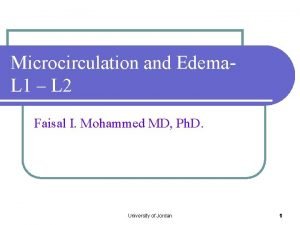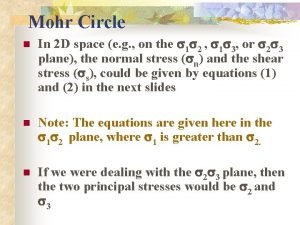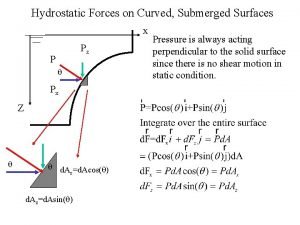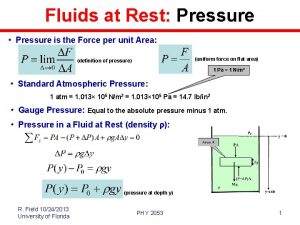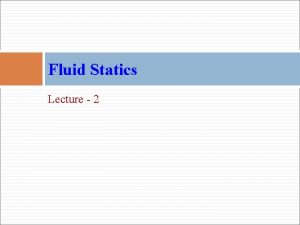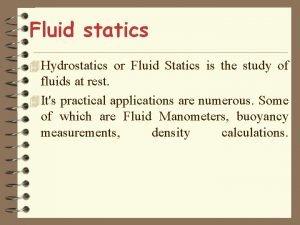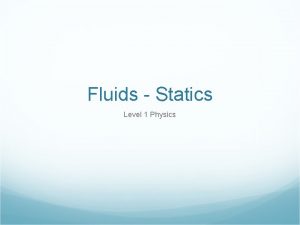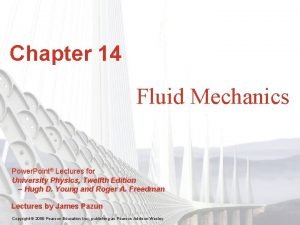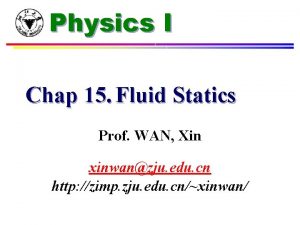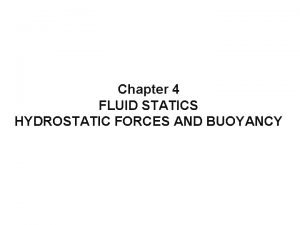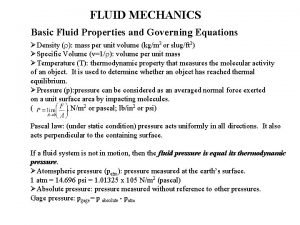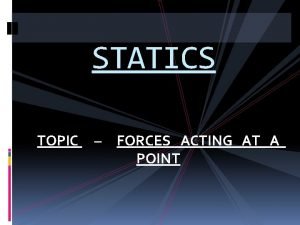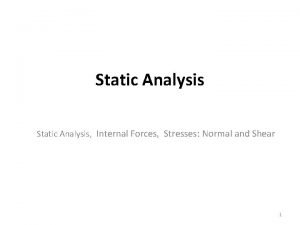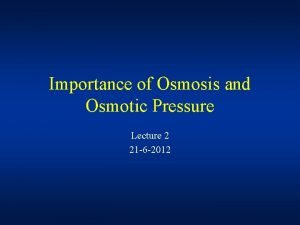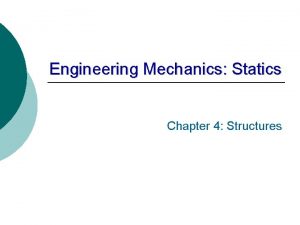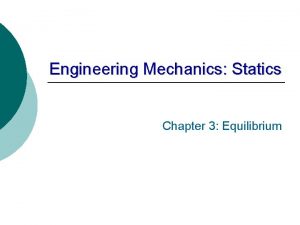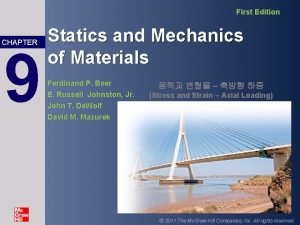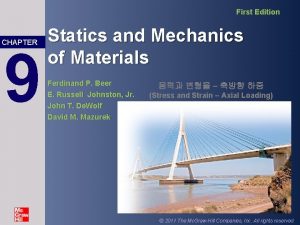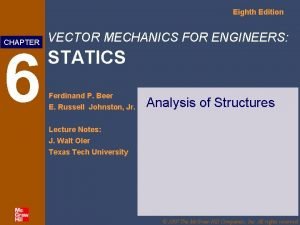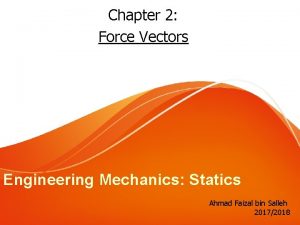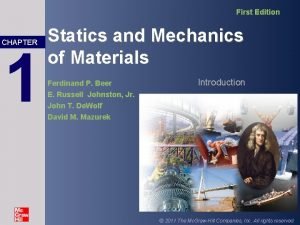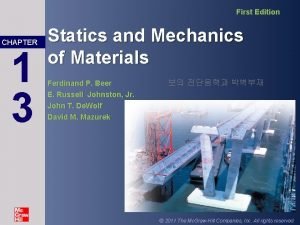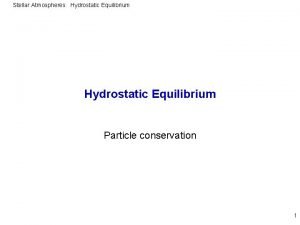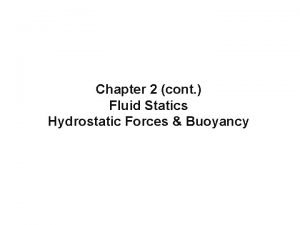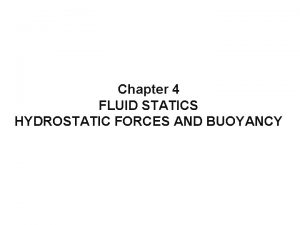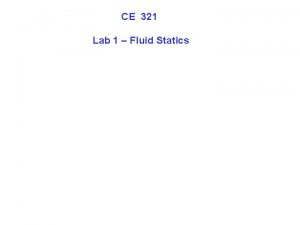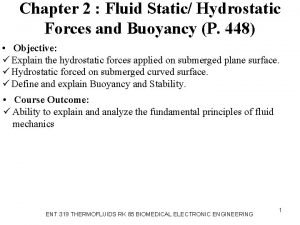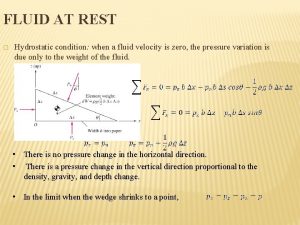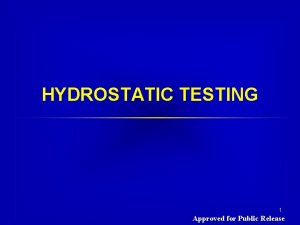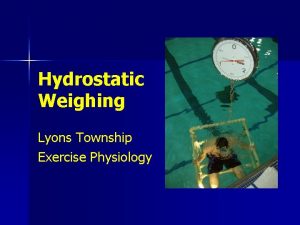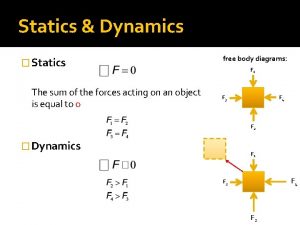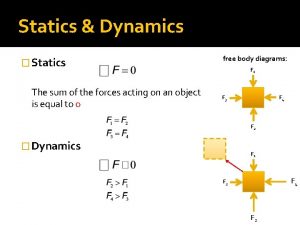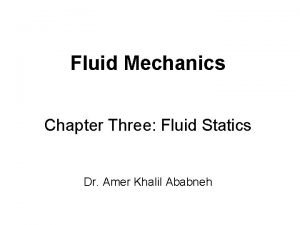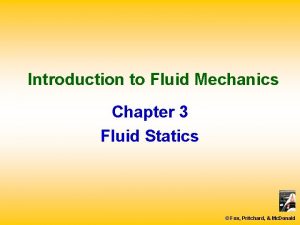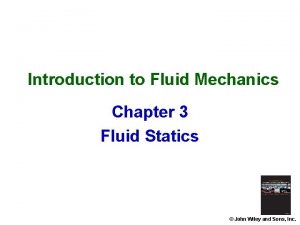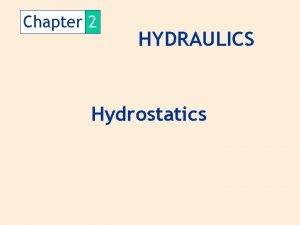Chapter 3 Cont FLUID STATICS HYDROSTATIC FORCES AND













































- Slides: 45

Chapter 3 (Cont. ) FLUID STATICS HYDROSTATIC FORCES AND BUOYANCY

FLUID STATICS Deals with problems associated with fluid at rest. No relative motion between adjacent layers. Thus, no shear stress (tangential stress) to deform the fluid. Liquid – hydrostatics; Gas – aerostatics.

FLUID STATICS The only stress in fluid statics is normal stress (perpendicular to surface) • Normal stress is due to pressure (Pressure: gravity field-weight of fluid) • Variation of pressure is due only to the weight of the fluid → fluid statics is only relevant in presence of gravity fields. Applications: Floating or submerged bodies, water dams and gates, liquid storage tanks, etc.

HYDROSTATIC FORCES F=PA Only when the pressure distribution is uniform over the entire area of interest.

HYDROSTATIC FORCES What about the areas where the pressure is non-uniformly distributed ? ? FIND THE AVERAGE PRESSURE AND WHERE IT ACTS

HYDROSTATIC FORCES ON PLANE SURFACES Problem • To find the resultant force FR (magnitude) and its point of application (center of pressure) for non-uniformly distributed pressure. **Atmospheric pressure Patm can be neglected when it acts on both sides of the surface.

EXAMPLE : Dam The Gathright Dam in Virginia is a rock-fill embankment dam. The Hoover Dam is an example of an arch-gravity dam.

EXAMPLE : Dam (cont. . ) The Grand Coulee Dam is an example of a solid gravity dam. Gordan Dam, Tasmania is an arch dam The Koshi Barrage dam

EXAMPLE : water gate (cont. . )

WHAT IS A RESULTANT FORCE AND CENTRE OF PRESSURE ? Engineering Mechanics Resultant force: A force that results from the combination of two or more forces. The centroid gives a definition of the mean position of an area (volume). It is closely related to the center of mass a body. COP: A point where the entire forces (Resultant force) were concentrated at a single point.

HOW TO DETERMINE THE RESULTANT FORCE Consider a flat plate completely submerged in a liquid. Plane of the top surface intersects with horizontal surface with an angle Ө, the line of intersection will be the z axis.

HOW TO DETERMINE THE RESULTANT FORCE, FR Absolute pressure at any point of the fluid, P = Po + ρgh, h = y sin Ө = Po + ρgy sin Ө, The resultant force, FR on the plate can be found by considering the differential area d. A that lies at a depth h from the liquid surface. d. FR = Pd. A The 1 st moments of areas are the average displacement of an area about an axis of rotation. They are closely related to the centroid. The magnitude of resultant force can be found by summing these differential forces over the entire surface FR = ∫ Pd. A =∫ (Po + ρgy sin Ө)d. A = Po. A + ρg sin Ө ∫yd. A if Po, ρ, g and Ө are constant **∫yd. A is the first moment of area with respect the x axis can be written as, yc A = ∫ yd. A where yc is the y coordinate of the centriod of area A measured from the x axis which passes through O

h = y sin Ө FR = (Po + ρgyc sin Ө) A = (Po + ρghc) A = Pc. A=Pavg. A The magnitude of the resultant force, FR acting on a plane surface of a completely submerged plate in a homogeneous (constant density) fluid is = the product of the pressure Pc at the centroid of the surface and the area A of the surface.

SUBMERGED RECTANGULAR PLATE : HOW TO DETERMINE THE RESULTANCE FORCE, FR.

How to determine the location of the COP? Line of action of resultant force FR=PCA does not pass through the centroid of the surface. In general, it lies below the centroid because pressure increase with depth.

How to determine the location of the resultant force (Center of Pressure) ? The vertical location of the line of action is determined by equating the moment of the resultant force, FR to the total moment of the distributed pressure force about the xaxis. Then, yp. FR = ∫A y. P. d. A =∫A y(Po + ρgy sin Ө) d. A = Po ∫A y d. A + ρgsin Ө ∫A y 2 d. A = Poyc. A + ρgsin Ө Ixx, o

The 2 nd moments of areas are the average (displacement)2 of an area about an axis of rotation. Has units of m 4 where Ixx, o = ∫y 2 d. A is actually the second moment of area (also called the area moment of inertia)about the x axis passing through point O. The second moments of area available for common shapes in engineering

Normally, the second moment of area is given about the axes passing through the centroid of the area. Therefore, we need parallel axis theorem to relate the Ixx, o and Ixx, c Therefore, If Po = 0(ignore the atmospheric pressure)

CENTROID AND CENTROIDAL OF INERTIA MOMENTS(2 nd MOMENT OF AREAS) FOR SOME COMMON GEOMETRIES

SUBMERGED RECTANGULAR PLATE : HOW TO DETERMINE THE C. O. P.

If Ө=90


Example 11 -1; Calculate FR, C. O. P and discuss whether the driver can open the door or not. The moment acting on the mid point of the submerged door is 101. 3 k. N x 0. 5 m = 50. 6 k. Nm, which is 50 times of the moment the driver can possibly generate. CAN’T OPEN.

EXAMPLE A 5 -m-high, 5 -m-wide rectangular plate blocks the end of a 4 -m-deep freshwater channel, as shown below. The plate is hinged about a horizontal axis along its upper edge through a point A and is restrained from opening by a fixed ridge at point B. Determine the force exerted on the plate by the ridge.

A SOLUTION s=1 m FR h=4 m Fridge B Then the resultant hydrostatic force on each wall becomes The line of action of the force passes through the pressure center, which is 2 h/3 from the free surface, Taking the moment about point A and setting it equal to zero gives

Solving for Fridge and substituting, the reaction force is determined to be Discussion The difference between FR and Fridge is the force acting on the hinge at point A.

EXAMPLE The 200 -kg, 5 -m-wide rectangular gate shown below is hinged at B and leans against the floor at A making an angle of 45° with the horizontal. The gate is to be opened from its lower edge by applying a normal force at its center. Determine the minimum forces F required to open the water gate.

FR SOLUTION 0. 5 m B 3 m 45 F A The average pressure on a surface is the pressure at the centroid (midpoint) of the surface, and multiplying it by the plate area gives the resultant hydrostatic on the surface, The distance of the pressure center from the free surface of water along the plane of the gate is

The distance of the pressure center from the hinge at point B is Taking the moment about point B and setting it equal to zero gives Solving for F and substituting, the required force to overcome the pressure is In addition to this, there is the weight of the gate itself, which must be added. In the 45 o direction, Thus, the total force required in the 45 o direction is the sum of these two values,

EXAMPLE Below shows an inclined plane wall 4 meter long, partially immersed in oil. The wall is subjected to a resultant hydrostatic force exerted by oil pressure. Calculate the resultant hydrostatic force on the wall due to the oil pressure. Determine the location of the centre of pressure (COP). Show the resultant hydrostatic force on the wall. Answer: FR = 46. 8 k. N Yp = 1. 32 m

EXAMPLE A pressurized contains oil (SG = 0. 90) and has a square, 0. 6 -m by 0. 6 -m plate bolted to its side, as is illustrated in Figure E 2. 8 (a). When the pressure gage on the top of the tank reads 50 k. Pa, what is the magnitude and location of the resultant force on the attached plate? The outside of the tank is atmospheric pressure. Answer: FR = 25. 4 k. N Yp = 0. 296 m

BUOYANCY An objects feels lighter and weigh less in fluid compare to in an air. Fluid exerts an upward force on a body immersed in it. This force that tends to lift the body is called the buoyant force or the force of buoyancy. Buoyant force is caused by the increase of pressure with depth in fluid. Difference between two hydrostatic forces at the top and bottom surface, which is buoyant force. FB = Fbottom – Ftop = ρfg(s+h)A – ρfgs. A = ρfgh. A = ρfg. V, V = h. A, volume of the plate.

We conclude that the buoyant force acting on the plate is equal to the weight of the liquid displaced by the plate. Archimedes principal : The buoyant force acting on a body immersed in a fluid is equal to the weight of the fluid displaced by the body, and it acts upward through the centroid of the displaced volume. FB=ρfg. V Density of fluid

Buoyancy of Floating Bodies For floating bodies, the weight of the entire body must be equal to the buoyant force, which is the weight of the fluid whose volume is equal to the volume of the submerged portion of the floating body. FB = W (The weight of the entire body must be equal to the buoyant force) ρf g. Vsub = ρave, bodyg. Vtotal Vsub / Vtotal = ρave, body / ρf (The submerged volume fraction is equal to the ratio of the average density of the body to the density of the fluid) Submerged portion (yellow) Displaced fluid whose volume = yellow volume LIQUID BOUYANT FORCE = WEIGHT OF DISPLACED FLUID

Three scenarios possible 1. rbody<rfluid: Floating body 2. rbody=rfluid: Neutrally buoyant 3. rbody>rfluid: Sinking body A solid body dropped into a fluid will sink, float, or remain at rest at any point in the fluid, depending on its average density relative to the density of the fluid.

Example application: Ship A ship floats on the surface of sea water if the upward buoyancy force that it receives is great enough to overcome the downward force of its weight. A steel ship is hollow inside so that the overall density of the ship is less than that of sea water. The level a ship sinks in the sea depends on the buoyant force that acts on it. The deeper a ship sinks in the sea, the larger the volume of sea water that is displaced. Hence the buoyant force increases. The density of sea water varies with location. This will vary the level that the ship sinks in the sea. The denser the sea water, the larger the buoyant force. The ship will submerge deeper in fresh water than in sea water. The density of sea water varies with the region it is in and the season it sails. Therefore, most ships are marked with the Plimsoll line(waterline). The Plimsoll line is painted on ships to show the depth a ship should travel at. http: //scienceray. com/technology/transport/the-motion-of-vehicles-inwater/3/#ixzz 0 u. Oj. M

Example application : Submarine To float a submarine: a) water is forced out from the ballast tank with compressed air. This decreases the density and weight of the submarine b) the buoyant force is larger than the weight of the submarine, causing the submarine to float. If the density of the submarine is the same as the density of the sea water, the depth of the submarine is maintained at one position. A submarine moves forward with the help of a propeller. A submarine has a large ballast tank used to control the position and depth of the submarine from the surface of the sea. To sink a submarine: a) the ballast tank is filled with water b) this increases the density and weight of the submarine c) the submarine sinks when its weight is larger than the buoyant force. Cross section of a vessel with a single ballast tank at the bottom.

Buoyance force by air is so small, V = 0. 1 m 3, ρair = 1. 2 kg/m 3 , FB = 1. 2 N. If mass = 80 kg, weigth = 788 N. Ignore the buoyancy, error is 0. 15%, so small. The rise of hot air or Helium balloons, and air movements in the atmosphere.

EXAMPLE A crane is used to lower weights into the sea (density = 1025 kg/m 3 ) for an underwater construction project as in figure. Determine the tension in the rope of the crane due to a rectangular 0. 4 m x 3 m concrete block (density = 2300 kg/m 3 ) when it is (a) suspended in the air and (b) completely immersed in water.

SOLUTION

EXAMPLE A Wood block (1) has dimensions of 10 mm x 50 mm and Specific gravity of 0. 3. A metal object (2) has volume of 6600 mm 3 Find the tension in the cable and mass of object 2.

SOLUTION

EXAMPLE A cube 0. 50 m on a side is made of bronze having a specific weight of 86. 9 k. N/m 3. Determine the magnitude and direction of the force required to hold the cube in equilibrium completely submerged (a) in water and (b) in mercury. The specific gravity of mercury is 13. 54.

EXAMPLE The 500 N flat-bottom container in figure (a) is 600 mm wide and 900 mm long. Determine the depth the container will float in the water (a) when it carries the 200 N steel block, and (b) when the block is suspended directly beneath the container as shown in figure (b). Take. Answer: (a) d =132 mm (b) d = 127 mm

End of Chapter 3 Any Question?
 P1-p2
P1-p2 Fluid statics deals with
Fluid statics deals with Cont or cont'd
Cont or cont'd Cont or cont'd
Cont or cont'd Oncotic pressure in capillaries
Oncotic pressure in capillaries Colloid osmotic pressure vs hydrostatic pressure
Colloid osmotic pressure vs hydrostatic pressure Complex stresses
Complex stresses Hydrostatic
Hydrostatic Fluids at rest
Fluids at rest Fluid statics
Fluid statics Bernoulli's theorem and its application
Bernoulli's theorem and its application Pressure vs depth equation
Pressure vs depth equation Fluid kinematics - ppt
Fluid kinematics - ppt Archimedes of syracuse
Archimedes of syracuse A 4m-long quarter-circular gate of radius 3 m
A 4m-long quarter-circular gate of radius 3 m Pressure gradient fluid mechanics
Pressure gradient fluid mechanics Forces acting at a point in statics
Forces acting at a point in statics Internal forces in structures engineering mechanics
Internal forces in structures engineering mechanics Analysis of internal forces
Analysis of internal forces Total body water
Total body water Extracellular fluid and interstitial fluid
Extracellular fluid and interstitial fluid Fluid sf
Fluid sf Solute definition
Solute definition Interstitial vs intracellular
Interstitial vs intracellular What is fluid kinematics
What is fluid kinematics Chylous ascites causes
Chylous ascites causes Short example of like parallel forces
Short example of like parallel forces Contact force
Contact force Force examples in everyday life
Force examples in everyday life Is erosion constructive or destructive
Is erosion constructive or destructive Force system statics
Force system statics What is oncotic pressure of blood
What is oncotic pressure of blood The forces shown above are
The forces shown above are Intramolecular forces vs intermolecular
Intramolecular forces vs intermolecular Similarities of intermolecular and intramolecular forces
Similarities of intermolecular and intramolecular forces Intermolecular force of attraction
Intermolecular force of attraction Chapter 4 statics
Chapter 4 statics Equilibrium engineering mechanics
Equilibrium engineering mechanics Statics chapter 9
Statics chapter 9 풀이
풀이 Statics chapter 6
Statics chapter 6 Statics chapter 2
Statics chapter 2 Statics chapter 1
Statics chapter 1 Statics
Statics Hydrostatic equilibrium
Hydrostatic equilibrium Radiation pressure formula
Radiation pressure formula




